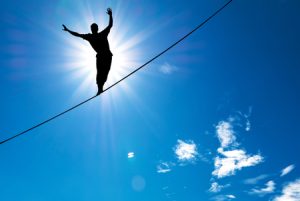
Maintaining a healthy and active sense of balance is imperative for living a dynamic life.
It is no news that fear of falling is one of the greatest fears for aging adults.
Have you ever tripped? It can be terrifying. Just think about the fear that rushes through your body when you start to fall!
Fear of falling is one of the strongest reflexes because your body will do everything in its power to prevent your noggin’ from hitting the floor!
The CDC reports that in the US alone we spend over 34 billion dollars in medical costs associated with falling. That says nothing about deaths, emotional trauma and the inability to get around and all of the lifestyle changes that ensue after a fall.
The CDC also says that 1 in 3 seniors over 65 will fall at some point in the course of a year. Clearly falling and balance are critical issues in our aging population.
Did you know that balance starts to decrease as early as our 20’s and declines with each passing year?
Depressing, I know, but here is some important knowledge- to improve balance you must challenge balance.
Our culture has become way too sedentary. We sit too much! We sit in our cars, we sit in front of the computer, we sit and watch TV. All of this sitting does not challenge balance and weakens or dulls the balance system.
Without getting too technical I want to briefly explore the three parts that comprise the balance system- the inner ear otherwise known as your vestibular system, eyesight, and proprioception. I call this the Balance Troika.
The Balance Troika.
- Inner ear or vestibular system is made up of 3 semicircular canals. They kind of remind me of a roller coaster. The way the vestibular system functions can get complicated but let’s just say that it constantly measures the body’s position in relationship to gravity. Along with the eyes, it helps us hold a gaze even though the body is moving. Try this: Hold your hand in front of you and shake your head from side to side rapidly. See how your hand stays in focus. Maybe some small details are out of focus. Now do the reverse. Move the hand very quickly in front of the eyes. See how different that is when the vestibular ocular reflex is not excited.
- Eyesight: Try this; stand up and stand on one leg. Then stand on the other leg. OK, now try standing on one leg and close your eyes. Aha, see how your vision affects your balance. It is incredibly difficult to stand on one leg with your eyes closed and not all that difficult to stand on one leg with your eyes open.
- Proprioception: Close your eyes and wave your hands in front of you. See you always know where they are. So Proprioception is the sense of the relative position of neighboring parts of the body and the strength of effort being employed in movement.
Let’s Challenge Balance!
- Squats: Squats are great because when done properly they allow for free movement in the hips. Because we sit too much many of us have a very limited range of motion through the hips. Click here for the squat video.
- Lunges: The lunge can be a little more challenging. Click on my video here for instruction. If you are a little wobbly place a chair on either side of you in case you need a handle.
- Walk the Plank: Click here for more instruction on walking the plank! You don’t need to be a pirate matey!
- Little Lifts: Click here for a video on what I call Little Lift balancing exercise.
- Lateral Lifts: The next two are in one video. Make sure that you do these near a chair or a counter in case you need support! Click here for the instructional video!
- Semi-Circle: See above video!
- Heel Raises: Foot and ankle flexibility are very important for balance. Heel raises help with both! Hmmm. I don’t have a video for this but here is the sequence- it is very simple.You may want to do this at a counter or with a chair in front of you. Stand with your feet about shoulder-width apart. Raise your heels so that you are on the balls of your feet. Lower your heels until they just about touch the floor BUT do not touch the floor then raise the heels again. Do 5-10 of these.
How You Move Matters! You can learn how to move better with my Amazon bestselling book Agility at Any Age: Discover the Secret to Balance, Mobility, and Confidence. My book is illustrated with 40 videos that you access with your iPad or smartphone! You can purchase it here.

My name is Mary Derbyshire. I am a fitness and movement coach. My methodology is the Alexander Technique, a mindfulness-based practice that teaches you how to move better. When you move better you feel better and when you feel better your whole life improves! Let me know what you think or ask a question! I love to hear from my readers! Feel free to post in the comments section below and feel free to share this with your friends!
·
·
·
Copyright: <a href=’https://www.123rf.com/profile_bolina’>bolina / 123RF Stock Photo</a>